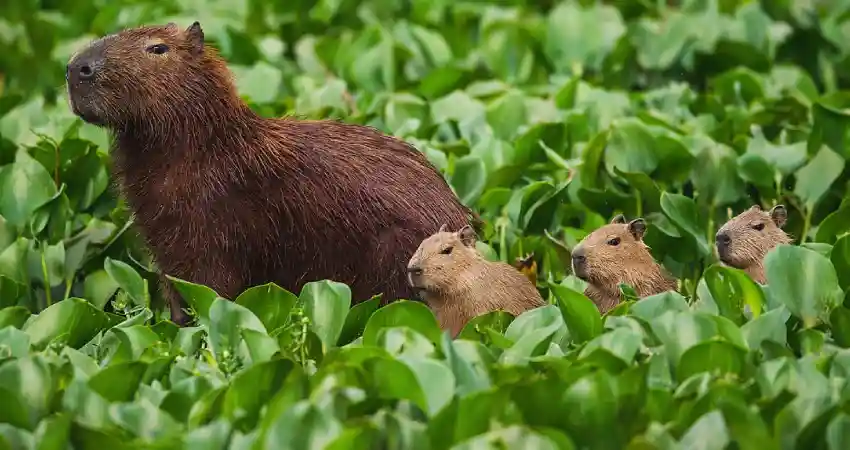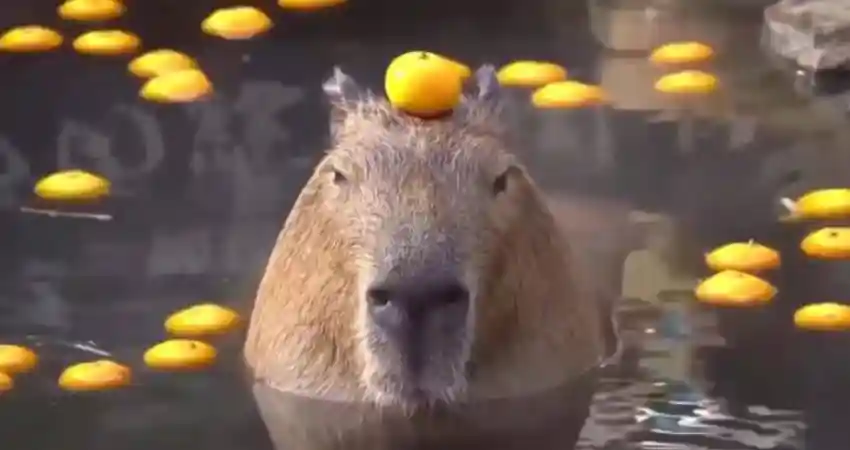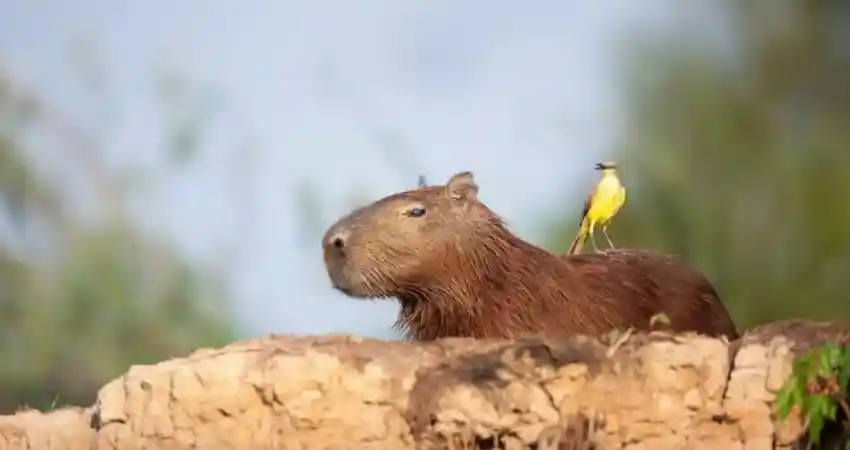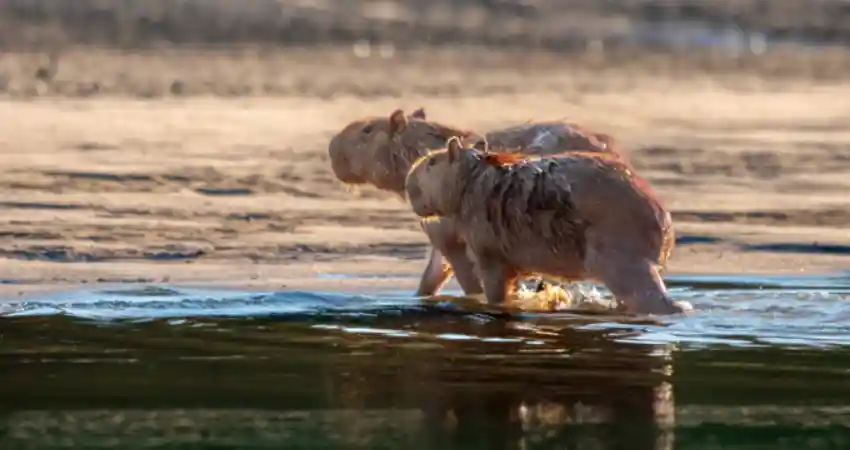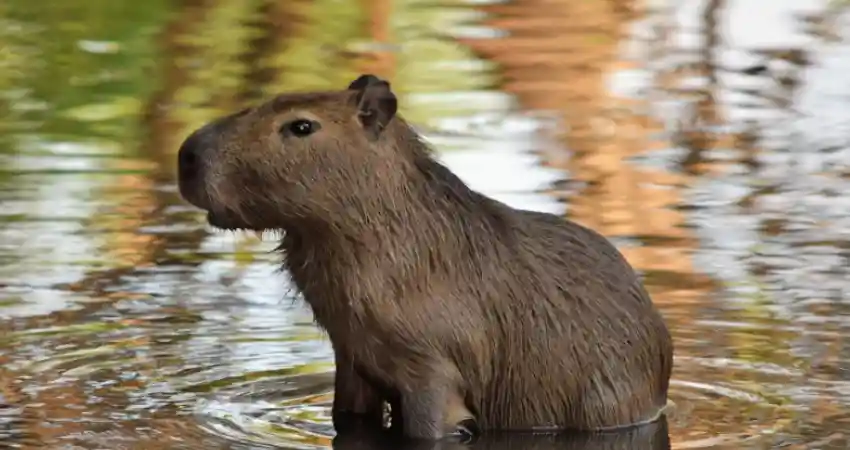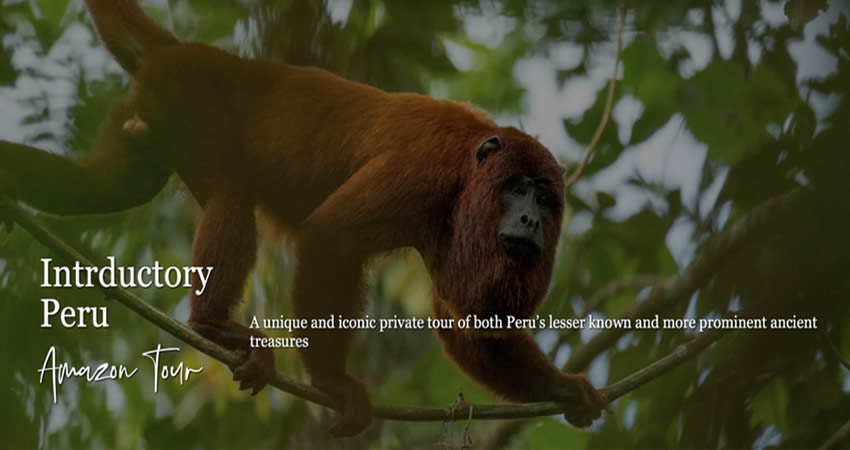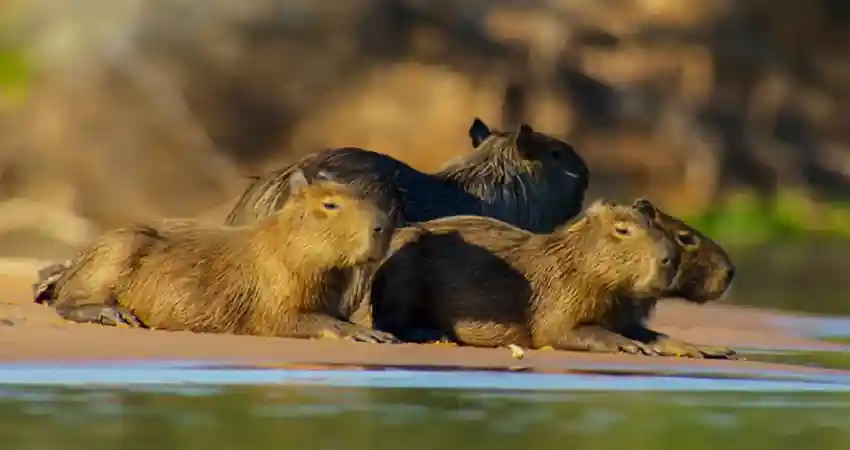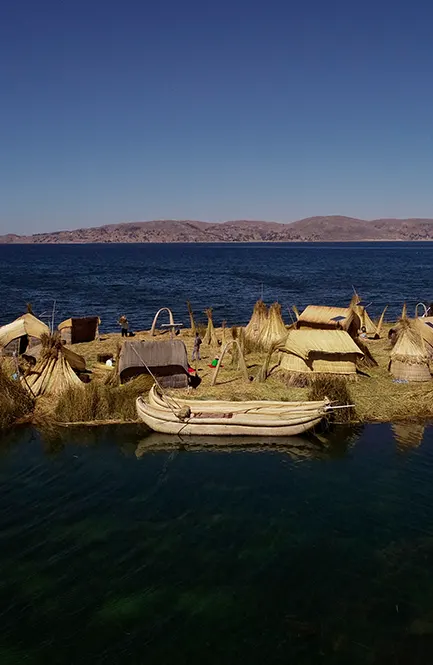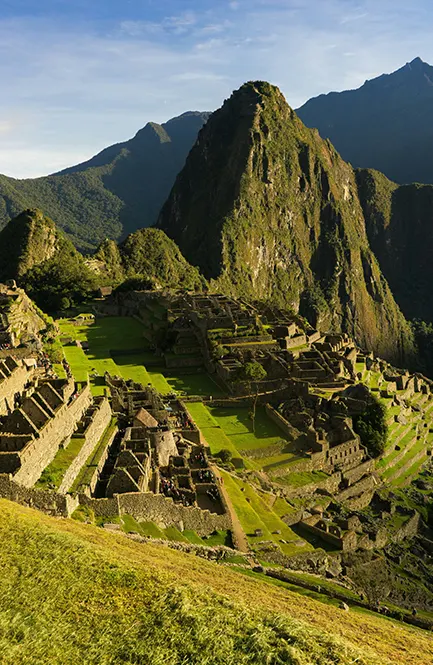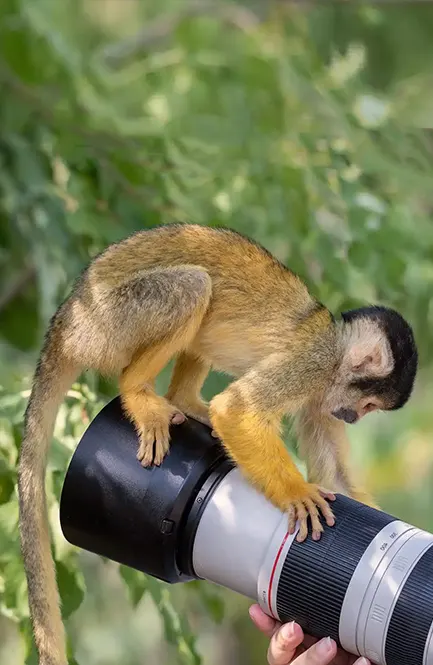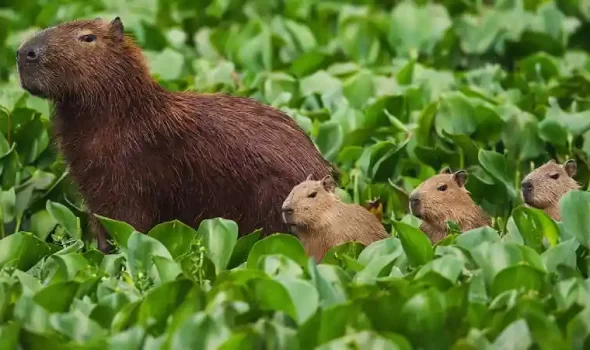1.- INTRODUCTION TO CAPYBARAS IN PERU
For those who are still wondering, Are there capybaras in Peru?, it is important to know that this peculiar animal is one of the largest rodents in the world and has a large number of specimens in Peru. It is popularly known as Ronsoco being catalogued as one of the emblematic and iconic species within the biodiversity of the wild fauna. It can weigh between 35 and 66 kg and at 1.3 m long it is impossible not to identify it. It can be found mainly in tropical areas near rivers and lakes. It has a quite robust body and a light brown coat that at first glance looks like a wild animal, however it is quite sociable as it can walk in groups of up to 20 specimens together, which somehow helps them to feel safe and face predators. Despite their large size they are actually quite peaceful species and their diet is essentially based on aquatic plants and herbs.
The Capybara Peru has a very important role in the Peruvian ecosystem because its existence in the aquatic ecosystem is a form of balance between vegetation and aquatic species because its diet consumes large amounts of plants which directly allows the growth of other species and promotes biodiversity within aquatic habitats. On the other hand, they are also the sustenance and food base for predators such as caimans and jaguars, which also gives a relationship of interdependence in the food chain. The observation of the Capybara amazon rainforest represents a great experience for travelers and ecotourism enthusiasts as this represents a special connection with nature allowing also to appreciate how the Capybara Peru interacts with other animals and in this way you can better understand the behavior in a wild social environment which helps to raise awareness among travelers and local people to the care and preservation of Peruvian ecosystems that are vital for biodiversity.
| “Discover the home of jaguars, capybaras, and exotic birds in a jungle paradise that only Peru can offer..” |
2.- ARE THERE CAPYBARAS IN PERU?
The Capybara Peru is recognized as the largest rodent in the world, its scientific name is Hydrochoerus hydrochaeris being one of the most iconic species of Peru’s biodiversity. Its presence is quite common mainly in the Amazon rainforest where they are considered as a very friendly species. Of course, for nature lovers, there are several places where it is possible to appreciate this wild animal.
2.1.- Amazon Region
One of the main places where you can appreciate the Peruvian Capybara is in the Madre De Dios region, which is considered one of the places where natural exploration becomes a unique adventure. This is because the city is surrounded by a large number of rivers and lakes that are considered ideal habitats for the Capybara Peru, in fact the biodiversity is really impressive being easily observable in places like the Tambopata National Reserve and the Bahuaja – Sonene National Park.
Being a sociable rodent, the Capybara Peru is easily seen in places where there is dense vegetation that is close to water, these places are ideal because they keep them cool and allow them to feed on aquatic grasses and local plants, for this reason the capybara can be seen during tourist activities that aim to know the rivers and small lakes.
2.2.- Pacaya Samiria National Reserve
From the city of Iquitos begins a special and unique adventure that allows you to get by boat to the Pacaya Samiria National Reserve, this natural area is unique as it extends over 2 million hectares comprising mainly tropical rainforest being cataloged as one of the most important places where you can appreciate the wildlife of biodiversity that exists in the Amazon, thanks to the presence of river systems Pacaya Samiria nature reserve is one of the places where you can see a countless number of wildlife species considering also a large population of capybaras.
During the boat trip many of the local guides provide you with information about wildlife and also allow you to easily locate the presence of these providers that mainly occurs during the rainy season, this time is key because the water level increases and the Capybara Peru approach the rivers to feed easily, it is also common to appreciate that during this season the presence of animals increases being one of the main activities that travelers enjoy to know the Amazon rainforest.
2.3.- Manu National Park
Considered as another emblematic destination for nature lovers and for those looking to enjoy activities such as ecotourism, this protected area is quite popular for the great biodiversity it possesses and also stands out for the presence of countless species of birds and a large intact vegetation, among these species is undoubtedly the Capybara Peru, as for world travelers who choose it as their destination can easily appreciate groups of this peculiar rodent while diving or emerging from the water looking to escape predators or just relaxing on a hot day.
Of course being a protected area has a greater restriction and its location is much more remote than other places so guided experiences are always organized from more distant places such as Cusco or Puerto Maldonado with the intention of being able to appreciate these unique animal species, during the trip thanks to the company of tour guides is possible to appreciate and understand more about the behavior of these peculiar animals and others that inhabit the area.
2.4.- Coast and mountains
It is popularly known that capybaras are mainly associated with the Amazon rainforest, however, exceptional and unconventional cases have also been reported in which they can be seen in groups in coastal and mountainous regions thanks to the presence of Amazonian rivers that flow and go through various parts of the country from the heights of the Andes to the plains, for this reason is that despite being remote places it is possible to find the presence of capybaras that have developed a resistance and adaptability to feed on the shores of lagoons.
In fact capybaras are quite adaptable although it is known that they prefer tropical and low altitude places, they can also be seen in high and cold places as long as there is water, in fact many of the ecosystems in the mountains and in the coastal region where this specimen can be seen are characterized mainly by the presence of large amounts of water that allow them to adapt in a better way. Of course, the frequency of Mentos sightings is much lower, however, due to the peculiar characteristic of adaptability that the capes have, it is possible to see how they look for a migration in search of new sources of food and resources to subsist.
3.- BEST TIMES TO SPOT CAPYBARAS IN PERU
Appreciating capybaras in their natural habitat is considered one of the best adventures that a nature lover can enjoy while visiting Peru, however it is important to understand that this may vary depending on the weather conditions and season in which you visit the Amazon Rainforest and of course the different regions of Peru. Peruvian biodiversity including capybaras have a behavior and migratory pattern that varies according to the season of the year.
- During the dry season that occurs between May and October is considered the best time to appreciate the groups of capybaras because this is the time of damage in which the water level decreases in rivers and lagoons so that the set of capybaras gather in areas near large bodies of water such as lakes and thus are much more visible in a simple and accessible way.
- The rainy season on the other hand occurs between November and April, considered as a season where the presence of rain increases so it is common to understand that the water level also rises causing that in this way the set of capybaras have more difficulty to be appreciated since the water floods certain areas of the jungle making it more difficult to locate them.
4.- Daily activity patterns
As already mentioned, capybaras are quite social animals and have a routine that has been called structured, since they are often influenced by weather conditions and the presence of light during the day, although they can be seen throughout the day, the main activity occurs during certain times of the day.
- During the first hours of the morning near dawn the capes are considered the most active because during this time they leave the nearby shelter to feed and it is possible to appreciate them better in large groups.
- At dusk their activity intensifies notably since during this time the temperature drops so the jungle becomes cooler and it is an ideal time to appreciate how the capes of the shore can be seen more easily.
- At midday it is common to perceive that the temperature is higher so the capybaras take refuge in shady places and even in the water that allows them to regulate the temperature and in this way they are less active and resting.
- Although capybaras do not migrate long distances, they do migrate between territories in search of places with more water. For this reason, during the dry season it is easier to see them moving from one place to another, but at a calm pace.
5.- A WILD LANGUAGE
“Something quite particular that people do not know about this species is that in fact they have a variety of sounds that after many studies have been determined that serve to communicate with each other, the main sounds that are known are whistles, grunts even has been recorded cases in which they can get to bark similar to dogs.”
6.- FREQUENTLY ASKED QUESTIONS ABOUT CAPYBARAS IN PERU
- Are capybaras dangerous to humans?
No, in no way does the Capybara Peru represent a danger to humans, they are specific and social animals so in general they are always friendly. However, if they feel threatened or cornered, they may bite, so be very cautious.
- What is the best month to see capybaras in Peru?
The best time of the year is undoubtedly during the dry season that occurs between May and October, as the water level drops, it is possible to see these beautiful creatures in search of a new place that has a constant source of water.
- Can you touch or feed capybaras during wildlife tours?
In general, it is recommended not to touch or feed these animals during a guided excursion because even though they are sociable and friendly animals, when they come into contact with a stranger they may feel threatened and react in an aggressive manner.
- How big do capybaras in Peru get compared to other regions?
The largest capybaras can measure between 1.1 m long and 1.3 m long and have a total weight between 35 kg and 65 kg, compared to species from other places such as Brazil or Venezuela there is no significant difference in size.
- What other animals are commonly seen alongside capybaras?
It is like being able to appreciate diverse types of animals together with the capybaras since these are sociable animals, mainly monkeys and birds.
Now you know a little more about this adorable species that you can appreciate during your next trip to Peru this 2025, however it is important that you understand that it is very important not to affect in any way their habitat and behavior for this reason you must plan your trip properly. Auri Peru is a responsible company that provides responsible travel options with a unique purpose allowing experiences that are not only fun but safe for travelers and for the biodiversity that exists in the country, contact us now and be part of a select group of travelers looking to enjoy a responsible trip.
“The Amazon awaits you. Do you dare?.”




